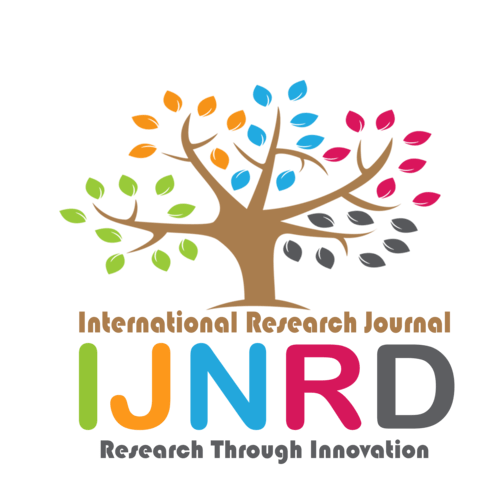|
|||||||||||||||

|
INTERNATIONAL JOURNAL OF NOVEL RESEARCH AND DEVELOPMENT International Peer Reviewed & Refereed Journals, Open Access Journal ISSN Approved Journal No: 2456-4184 | Impact factor: 8.76 | ESTD Year: 2016 Scholarly open access journals, Peer-reviewed, and Refereed Journals, Impact factor 8.76 (Calculate by google scholar and Semantic Scholar | AI-Powered Research Tool) , Multidisciplinary, Monthly, Indexing in all major database & Metadata, Citation Generator, Digital Object Identifier(DOI) |
||||||||||||||
Issue: May 2024
Volume 9 | Issue 5
Review Result and Publication of Paper within : 2-3 days
Click Here For more DetailsFor Authors
Forms / Download
Published Issue Details
Editorial Board
Other IMP Links
Facts & Figure
Impact Factor : 8.76
Issue per Year : 12
Volume Published : 9
Issue Published : 96
Article Submitted :
Article Published :
Total Authors :
Total Reviewer :
Total Countries :
Indexing Partner
Join RMS/Earn 300
Licence
This work is licensed under a Creative Commons Attribution-NonCommercial 4.0 International License







|
Published Paper Details
|
|
| Paper Title: | TRAFFIC MANAGEMENT SYSTEM USING MACHINE LEARNING |
| Authors Name: | Ms. S.Agnes Joshy , M. Dhana Sakthi , C. Jenit Catherin , T. Danamaliga |
| Download E-Certificate: | Download |
| Author Reg. ID: |
IJNRD_218694
|
| Published Paper Id: | IJNRD2404547 |
| Published In: | Volume 9 Issue 4, April-2024 |
| DOI: | |
| Abstract: | Urban regions frequently experience traffic congestion at intersections, which results in lost time, higher fuel use, and environmental pollution. Conventional traffic signal management systems frequently depend on simple timers or set schedules, which can lead to inefficiencies during periods of high traffic or in the event of unforeseen circumstances. However, technological developments, especially in the fields of artificial intelligence and vehicle detection, present viable ways to enhance traffic management. The goal of this project is to design a smart traffic light control system that maximizes intersection signal timing by utilizing machine learning algorithms and vehicle identification techniques. The technology may dynamically modify signal phases and durations to accommodate changing traffic flows and reduce congestion by correctly recognizing the presence and movement of cars in real-time. Vehicle detection sensors, adaptive signal control algorithms, real-time traffic analysis algorithms, and coordination mechanisms for junction optimization are some of the main parts of the system. In order to gather information on vehicle movements, vehicle detection sensors—such as cameras or radar systems—are placed at intersections. After that, this data is processed to reliably identify automobiles using computer vision algorithms or other detection methods. Understanding the current traffic situation is achieved through the processing of data gathered from vehicle detection sensors by the real-time traffic analysis component. The technology is able to make proactive adjustments to signal timing because machine learning algorithms are used to analyze traffic patterns and anticipate changes in demand. The algorithms for adaptive signal control dynamically modify signal timing in response to actual traffic flow. They prioritize signal phases for directions with high demand and allot green time accordingly. The system maximizes traffic flow along arterial highways and reduces delays by coordinating traffic signals at nearby crossings. In addition to reducing traffic, the suggested Smart Traffic Light Control System also improves safety, the environment, and efficiency. The technology promises to produce safer, more efficient, and sustainable urban transportation networks by dynamically adjusting signal timings in response to changing traffic circumstances. In summary, traffic light control systems that use machine learning and vehicle identification technologies have the potential to completely transform urban traffic management. This project's Smart Traffic Light Control System is a big step in the right direction toward solving the problems associated with traffic congestion and raising the standard of city transportation systems as a whole. |
| Keywords: | Machine Learning, Vehicle Detection ,Traffic Signal Control,Traffic Flow Optimization , Object Detection,Predictive Modeling,Grid-based Traffic Analysis,Yolo V5,Traffic Simulation. |
| Cite Article: | "TRAFFIC MANAGEMENT SYSTEM USING MACHINE LEARNING", International Journal of Novel Research and Development (www.ijnrd.org), ISSN:2456-4184, Vol.9, Issue 4, page no.f375-f384, April-2024, Available :http://www.ijnrd.org/papers/IJNRD2404547.pdf |
| Downloads: | 00027 |
| ISSN: |
2456-4184 | IMPACT FACTOR: 8.76 Calculated By Google Scholar| ESTD YEAR: 2016 An International Scholarly Open Access Journal, Peer-Reviewed, Refereed Journal Impact Factor 8.76 Calculate by Google Scholar and Semantic Scholar | AI-Powered Research Tool, Multidisciplinary, Monthly, Multilanguage Journal Indexing in All Major Database & Metadata, Citation Generator |
| Publication Details: |
Published Paper ID:IJNRD2404547 Registration ID: 218694 Published In: Volume 9 Issue 4, April-2024 DOI (Digital Object Identifier): Page No: f375-f384 Country: -, -, India Research Area: Engineering Publisher : IJ Publication Published Paper URL : https://www.ijnrd.org/viewpaperforall?paper=IJNRD2404547 Published Paper PDF: https://www.ijnrd.org/papers/IJNRD2404547 |
| Share Article: | |
|
Click Here to Download This Article |
|
| Article Preview | |
|
|
|
Major Indexing from www.ijnrd.org
| Semantic Scholar | Microsaoft Academic | ORCID | Zenodo |
| Google Scholar | ResearcherID Thomson Reuters | Mendeley : reference manager | Academia.edu |
| arXiv.org : cornell university library | Research Gate | CiteSeerX | PUBLON |
| DRJI | SSRN | Scribd | DocStoc |
ISSN Details
 |
 |
ISSN: 2456-4184
Impact Factor: 8.76 and ISSN APPROVED
Journal Starting Year (ESTD) : 2016
DOI (A digital object identifier)
Conference
Open Access License Policy
Important Details
Social Media
| Copyright © 2024 - All Rights Reserved - IJNRD |












Facebook Twitter Instagram LinkedIn